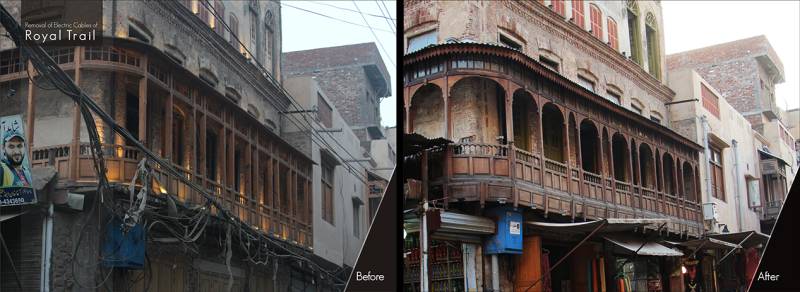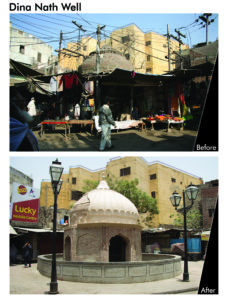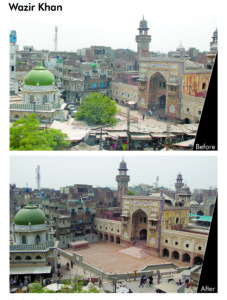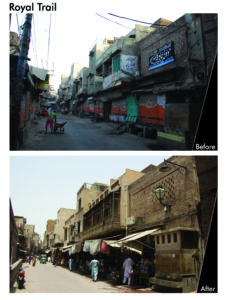
Despite the hustle and bustle of life, daily business activities and echoes of joys and life, the locality inside Delhi Gate of Lahore seemed colorless and dull with no one from the greater Lahore knowing about it. The giant 17th century monuments were standing, but in dilapidated condition and even the locals of the area had lost interest in them because those monuments were not meant for tourism. People from the greater Lahore avoided going to this place, which had the history of centuries hidden in its streets and houses, because of the smelly drains running on both the borders of the street and stagnant water resting in pits on the main streets. Same was the view of the smaller streets and alleys were mice lived with humans, piles of waste and garbage ruined the decorated borders of the houses and ugly hanging wires and huge ill maintained electricity poles and transformers hampered the scenic view of the historic houses and monuments. Tourist going there was out of question and walled city of Lahore was always thought of as a place having rigid minded people, stinking streets, heavy freight traffic and nothing to see except the grand mosque and fort!
Walled City of Lahore was a place which once gave birth to the stories of many writers, view for the painters and kingdom for the rulers. After the numerous years of commotion, turmoil and tranquility Lahore became a dream city in 1500s when the Mughal Empire made it one of its capitals. That was the time when the zenith of the city, majestic buildings in galore and monuments surged and the city started getting a new look.
The Lahore city was given a shape by the Mughal emperor Akbar, who built a thirty feet high fortified wall around the city with twelve gates and a Mori. The Mori was given the status of a gate later. Thus, Lahore became an alluring city of thirteen gates.
After 1947, the beauty of the city could not be kept unscathed and countless alterations and additions endangered the magnificence subconsciously. The utmost threat to the city’s heritage was the extent of continuous commercialization. The buildings and monuments were falling apart and no one was there to pay heed to the vanishing heritage.

Shahi Guzargah or the Royal Trail was also a forgotten part of the city which was inside Delhi Gate, one of the thirteen gates of Lahore. The trail having magnificent monuments was lost under the dust of times and Delhi Gate was damaged due to negligence and aging, Shahi Hammam was encroached upon by almost fifty two shops and was breathing its last while the havelis were crumbling and Wazir Khan Mosque was all encroached upon by almost seventy eight shops and lost behind them.
The locals had started moving out of the walled city and the havelis and the monuments were desolated. At the same time, the heritage lovers and historians were also fearing that this place might lose its pure identity.
In 2012, the government of Punjab realized the severity of the matter and established Walled City of Lahore Authority to take up the restoration and maintenance of the entire walled city. Finally the newly made authority started its plans to restore the city and fortunately selected the Shahi Guzargah for restoration.

This “Royal Trail” or Shahi Guzargah is the path which the Mughal and Royals used while travelling from Delhi to the Lahore Fort. You can visualize the striking entourages entering through the huge Delhi Gate and approaching the Fort, people standing in the balconies and jharokas, trying to take a glimpse of their kings, queens and the royal family. Those who got a chance to see the majestic scene would narrate the stories of their gorgeousness to others and that was how the storytelling was started. The myths go that many of the girls fell in love with the handsome princes and many young boys went for the gorgeous princesses or the courtesans and looked for them throughout their life.
To tell more about Shahi Guzargah, it is almost one and a half kilometer long trail from Delhi Gate to the Mighty Royal Fort of Lahore through Masti Gate. The most appealing and compelling section of the trail are the world class monuments located on it. One can see the huge arched Delhi gate, gorgeous Shahi Hammam ( Royal Bath), Wazir Khan Mosque, historic havelis, Sonehri Mosque, Mariam Zamani Mosque and Lahore Fort on the Royal Trail. The biggest spice and cloth market of Asia is also there. In short you step on to the Royal Trail and you will be carried away by the mind blowing sites and sights and an unseen trance will accompany you.

With aggressive working, finally, the royal trail was restored to its original glory by the Walled City of Lahore Authority in partnership with Aga Khan Culture Services Pakistan. This was done in parts. The first part from Delhi Gate to Chowk Kotwali was restored in 2014 and the second part from Chowk Kotwali to Masti Gate was completed in 2017.
The works done were the infrastructure improvements and façade rehabilitation of almost 99 streets, 1500 properties and the total length of the street was 1.6km. Finally, all the ugly hanging wires, Sui gas meters and telecommunication wires were taken underground. Such interventions were made for the first time and till now such infrastructure services are not seen in the greater Lahore. The facades of the houses and havelis were also restored. To improve the water, sanitation and sewerage system, the open drains were closed so that the public could not see them, the 200 years old storm and sewerage water pipes were separated and repaired. Interestingly, the repairs of the façade (exterior of the buildings) were carried out using the same material in which they were originally built, known as kankar lime plaster and small bricks.
Encroachments were removed from Shahi Hammam and later it was also conserved while encroachments from Wazir Khan Mosque were also removed and thus it was also conserved.
It is good to see that the residents of this part of the city are now happy and getting all the modern infrastructure services but in a concealed manner. To clean up the space a solid waste management plan was also implemented and now you will not see any waste or garbage lying in the streets or the main trail.
With the restoration of the trail, tourists started coming to see this part of the city and thus for the first time the walled city of Lahore was made a brand and marketed before the public. Tourists came and visited all parts of the city and for the first time street tourism picked up.
This was a new life given to the dying heritage and I am hopeful that very soon other parts of the city will also be restored on the same lines.
Walled City of Lahore was a place which once gave birth to the stories of many writers, view for the painters and kingdom for the rulers. After the numerous years of commotion, turmoil and tranquility Lahore became a dream city in 1500s when the Mughal Empire made it one of its capitals. That was the time when the zenith of the city, majestic buildings in galore and monuments surged and the city started getting a new look.
The Lahore city was given a shape by the Mughal emperor Akbar, who built a thirty feet high fortified wall around the city with twelve gates and a Mori. The Mori was given the status of a gate later. Thus, Lahore became an alluring city of thirteen gates.
After 1947, the beauty of the city could not be kept unscathed and countless alterations and additions endangered the magnificence subconsciously. The utmost threat to the city’s heritage was the extent of continuous commercialization. The buildings and monuments were falling apart and no one was there to pay heed to the vanishing heritage.

Shahi Guzargah or the Royal Trail was also a forgotten part of the city which was inside Delhi Gate, one of the thirteen gates of Lahore. The trail having magnificent monuments was lost under the dust of times and Delhi Gate was damaged due to negligence and aging, Shahi Hammam was encroached upon by almost fifty two shops and was breathing its last while the havelis were crumbling and Wazir Khan Mosque was all encroached upon by almost seventy eight shops and lost behind them.
The locals had started moving out of the walled city and the havelis and the monuments were desolated. At the same time, the heritage lovers and historians were also fearing that this place might lose its pure identity.
In 2012, the government of Punjab realized the severity of the matter and established Walled City of Lahore Authority to take up the restoration and maintenance of the entire walled city. Finally the newly made authority started its plans to restore the city and fortunately selected the Shahi Guzargah for restoration.

This “Royal Trail” or Shahi Guzargah is the path which the Mughal and Royals used while travelling from Delhi to the Lahore Fort. You can visualize the striking entourages entering through the huge Delhi Gate and approaching the Fort, people standing in the balconies and jharokas, trying to take a glimpse of their kings, queens and the royal family. Those who got a chance to see the majestic scene would narrate the stories of their gorgeousness to others and that was how the storytelling was started. The myths go that many of the girls fell in love with the handsome princes and many young boys went for the gorgeous princesses or the courtesans and looked for them throughout their life.
To tell more about Shahi Guzargah, it is almost one and a half kilometer long trail from Delhi Gate to the Mighty Royal Fort of Lahore through Masti Gate. The most appealing and compelling section of the trail are the world class monuments located on it. One can see the huge arched Delhi gate, gorgeous Shahi Hammam ( Royal Bath), Wazir Khan Mosque, historic havelis, Sonehri Mosque, Mariam Zamani Mosque and Lahore Fort on the Royal Trail. The biggest spice and cloth market of Asia is also there. In short you step on to the Royal Trail and you will be carried away by the mind blowing sites and sights and an unseen trance will accompany you.

With aggressive working, finally, the royal trail was restored to its original glory by the Walled City of Lahore Authority in partnership with Aga Khan Culture Services Pakistan. This was done in parts. The first part from Delhi Gate to Chowk Kotwali was restored in 2014 and the second part from Chowk Kotwali to Masti Gate was completed in 2017.
The works done were the infrastructure improvements and façade rehabilitation of almost 99 streets, 1500 properties and the total length of the street was 1.6km. Finally, all the ugly hanging wires, Sui gas meters and telecommunication wires were taken underground. Such interventions were made for the first time and till now such infrastructure services are not seen in the greater Lahore. The facades of the houses and havelis were also restored. To improve the water, sanitation and sewerage system, the open drains were closed so that the public could not see them, the 200 years old storm and sewerage water pipes were separated and repaired. Interestingly, the repairs of the façade (exterior of the buildings) were carried out using the same material in which they were originally built, known as kankar lime plaster and small bricks.
Encroachments were removed from Shahi Hammam and later it was also conserved while encroachments from Wazir Khan Mosque were also removed and thus it was also conserved.
It is good to see that the residents of this part of the city are now happy and getting all the modern infrastructure services but in a concealed manner. To clean up the space a solid waste management plan was also implemented and now you will not see any waste or garbage lying in the streets or the main trail.
With the restoration of the trail, tourists started coming to see this part of the city and thus for the first time the walled city of Lahore was made a brand and marketed before the public. Tourists came and visited all parts of the city and for the first time street tourism picked up.
This was a new life given to the dying heritage and I am hopeful that very soon other parts of the city will also be restored on the same lines.
